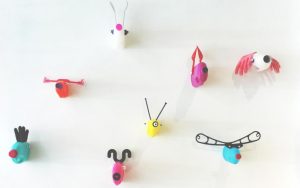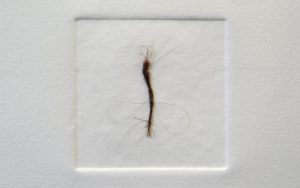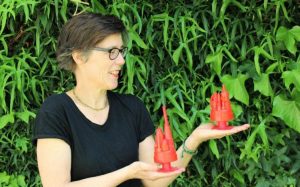Je kan niet anders dan grijnzen in het aanzicht van een schattig kwalletje bestaand uit een flesje en een sinaasappelnet. Een sprayflacon met een welgeplaatst dopje wordt een pinguin, of een gans. Zelfs in elkaar gerolde haren, geoogst uit een wasmachine, ontkomen niet aan Adriaansche’s universum: een vliegenfamilie, genaamd Musca capillus. Het doet iets met je manier van kijken.
‘Waar koop je hier lijmpistolen?’ Carolien Adriaansche heeft haast. Twee weken tijd heeft ze, om een kunstwerk te maken, een workshop te geven en materiaal te verzamelen. Aarhus Billedkunstcenter (AABKC), een lokaal centrum voor beeldende kunst, heeft haar uitgenodigd als artist-in-residence.
Het kunstwerk dat ze gaat maken is een speciale opdracht van Rethinking Matter, een project van AABKC [hints]Rethinking Matter heeft in een half jaar drie tentoonstellingen georganiseerd, waarvan Biotic Synthetic de laatste is. De eerste ging over tastzin, de tweede over het spanningsveld tussen digitale processen esthetiek en materie. En de derde, Biotic Synthetic, over organische en synthetische materialen, en de tegenstelling natuur-cultuur.[/hints] in het kader van Aarhus Europese Culturele Hoofdstad (ECC), ofwel #Aarhus2017. Het verwijst naar een van de thema’s van #Aarhus2017: duurzaamheid. Curator Pamela Grombacher ontdekte Carolien Adriaansche’s werk op internet en viel voor de manier waarop Adriaansche biodiversiteit benadert. Uit het materiaal dat de biodiversiteit van deze planeet bedreigt, schept ze een nieuwe, paralelle biodiversiteit. Van plastic.

Dat lijkt banaal en belerend, maar zo komt het niet over als je oog in oog met haar scheppingen staat. Eerder inventief, bij vlagen komisch, maar altijd vrolijkmakend. Je kan niet anders dan grijnzen in het aanzicht van een schattig kwalletje bestaand uit een flesje en een sinaasappelnet. Een sprayflacon met een welgeplaatst dopje wordt een pinguin, of een gans. Zelfs in elkaar gerolde haren, geoogst uit een wasmachine, ontkomen niet aan Adriaansche’s universum: een vliegenfamilie, genaamd Musca capillus. Het doet iets met je manier van kijken.

Plasticobsessie
Oorspronkelijk is Carolien Adriaansche (1963) opgeleid als theatervormgever en illustrator aan de Rietveld Academie. Naderhand is ze begonnen met haar bedrijf De Afvaljuf. Daarmee organiseert ze workshops voor scholen en bedrijven met, hoe kan het ook anders, afvalplastic.
Ze heeft iets met verzamelingen en families. ‘Het begon toen ik klein was en we op vakantie waren in Frankrijk. We bezochten het natuurhistorische museum van Bordeaux, en ik raakte diep onder de indruk van de veelheid, de veelsoortigheid, en al die kleurig gerangschikte verzamelingen.’
Hoe die verzamelingen uiteindelijk opdoken in haar werk heeft te maken met duurzaamheid. ‘Het begon me op te vallen hoe onontkoombaar veel plastic we gebruiken. Begrijp me goed: plastic is een prachtig materiaal. Maar het viel me ook op dat we het meestal maar één keer gebruikten. Enorme hoeveelheden worden tot afval. Sinds kort moeten we het wel inzamelen voor hergebruik, maar dat is nog steeds enorm duur. En het daarmee gepaard gaande vervoer vervuilt óók.’

Parallelle biodiversiteit
Het besef dat de biodiversiteit bedreigd wordt, liet haar niet los. Daardoor is ze verzamelingen gaan maken van een parallelle, zelfgemaakte biodiversiteit. En zo is plastic haar obsessie geworden. ‘In supermarkten ben ik me altijd bewust van verpakkingen.’ Op straat houdt ze een half oog op zwerfafval, en voor een rondje dumpster diving (dingen zoeken in grote vuilcontainers) draait ze haar hand niet om. Festivals zijn ook goede vindplaatsen voor grote hoeveelheden van één soort (of kleur) plastic. En op Nieuwjaarsdag is het inmiddels een vaste traditie dat ze een wandeling maakt door de buurt, en plastic onderdelen van vuurwerk verzamelt.
Maar in haar eentje krijgt ze niet voldoende plastic bij elkaar. Dus heeft ze van lieverlee een netwerk opgebouwd van kennissen en bedrijven die spullen voor haar bewaren en verzamelen. ‘Het grappige is dat veel mensen vaak dingen verzamelen die ik zelf niet zou kiezen, maar zo kom je weer op nieuwe ideeën.’
Van Plastic Soep naar zeewezens
Ook in Aarhus heeft ze hulp. Bij aankomst bleek dat de organisatie van AABKC zelf al plastic dozen, flessen, doppen, netjes en andere dingen had opgespaard. En tijdens een workshop met vier andere kunstenaars is ze geholpen bij het maken van plastic dieren. Want het was vooraf wel duidelijk dat ze zo’n groot kunstwerk, speciaal voor die plek, niet zonder hulp kon maken.
Het plastic in Denemarken, en het verzamelen ervan, is toch wel anders dan in Nederland. ‘Het valt me op dat er zo weinig zwerfafval is. Daarom ben ik op bouwplaatsen gaan zoeken, en daar waren ze wel blij met me. “Dan hoeven we het tenminste niet zelf weg te gooien”, hoorde ik een paar keer. Ook is het plastic niet erg kleurrijk, en in de supermarkten die ik heb gezien was ook niet zo veel keuze.’
Overigens kun je je ook vergissen in wat afval is. ‘Ik vond een rol rood band op straat, en laadde dat op mijn fiets. Maar een eindje verder vond ik wéér zo’n rol. En nog een, en nog een. Toen begreep ik dat het spul was dat ze alvast hadden klaargelegd voor wegwerkzaamheden!’ Gauw heeft ze de rol weer teruggelegd.

Focus
Inmiddels is het kunstwerk op een haar na klaar. De verworven lijmpistolen kunnen terug in hun holsters, het vliegensvlug met plastic volgelopen atelier is al weer bijna leeg en de leenfiets moet ze weer inleveren. ‘Het was heerlijk om twee weken lang alleen maar hard aan kunst te werken. Thuis word ik toch vaak afgeleid door familie, huishouden, mijn bedrijf de Afvaljuf en allerlei andere dingen. Pure luxe om je alleen maar te hoeven focussen op één ding!’
Op 19 mei is ze weer terug in Aarhus voor de opening van de tentoonstelling, waar haar werk deel van uitmaakt: Biotic Synthetic.
Biotic Synthetic is tot 25 juni te zien in kunstcomplex Godsbanen, Aarhus. Het is het laatste deel van een tentoonstellingsdrieluik, verder bestaande uit The Tactile en Digital Materiality.
Meer over Carolien Adriaansche vind je hier: http://carolienadriaansche.nl/ en hier: http://afvaljuf.nl/
Meer over Aarhus Billedkunstcenter hier https://aabkc.dk/ en over Rethinking Matter hier: http://www.rethinkingmatter.com/biotic-synthetics/
